American Sabbatical 016: 9/18/96
Cedar Rapids
|
Message sent from Yankton, South Dakota: Hopping like frogs in the rain, and it sure knows how to rain
out here. I’ll try not to look down on you lowlanders as we approach
the 100th meridian, on the long upslope to the top of America.
We discovered why Peggy hadn’t been hearing from her colleagues.
She has been using the wrong address. The teacher she’d been calling
on the phone had been getting hers, but the rest weren’t. We noticed
the return receipt feature a little late in the game.. all those
pleading missives gone into the digital black hole.. but better
late than never. On the friends&family front, however, this connection
has been wonderful. We are up and talking to old friends we haven’t
been in touch with for years, touching base with near and dear
almost daily, and making the local rounds in Bowdoinham, just
like visiting at the Town Landing. They weren’t kidding when they
hyped this as an electronic village.
Out here on the edge of the Great American Desert this gathering
of folks from afar has a deep historic resonance. Today we crossed
the wide Missouri, and it was on her banks that the emigrant trains
for the Far West made up: in towns like Independence, St. Jo,
Council Bluffs. It was here, where the high plains begin, that
groups of strangers formed democratic units, elected wagonmasters,
fought over routes, wrestled with unfamiliar animals and manners,
and started off on their incredible treks. Our e-mailbox has filled
up like a marshaling yard on the Missouri bluffs. I feel like
there’s a whole train of you following us blindly into the tall
grass. Hope we do better than Donner.. but I proceed ourselves.
Back to the blow by blowhard: |
|
9/18...Cedar Rapids
Our feet were on fire and our eyes were steaming when we hit Cedar Rapids. And Why Cedar Rapids? you might ask.
First because Peggy’s great-grandfather opened a seed store there
in the 1880’s, and second because the Art Museum has a big collection
of local boy Grant Wood, and the more we looked at Iowa, the more
we realized his genius. But, we hadn’t realized that Quaker Oats
has a big mill hard by the banks of the Cedar, so we discovered
another shrine to visit. Our morning camp ritual begins with Quaker
Oats, and now we’ve seen before the beginning.
Back in 1964, when I hitch-hiked to New Orleans at spring break
(actually got to Shreveport and some lake in Texas), I ended up
walking through Richmond, Virginia, in a sultry noontime. Those
days I was smoking Lucky Strikes, and Lo, there was the Lucky
Strike factory. I went up and kissed the wall. It seemed right.
(And tasted about the way the memory of all those butts does now.)
In Cedar Rapids I stood a bit farther back and kissed the oat
elevators with watercolors.
| Our morning in the Oat City started at the Art Museum, which has
to be the most welcoming venue in the biz. A post-deco edifice
in loud colors with a soaring lobby, friendly spaces and very
lo-key staff. Maybe even ho-key. Which fitted with the art.. definitely
corn-fed. |
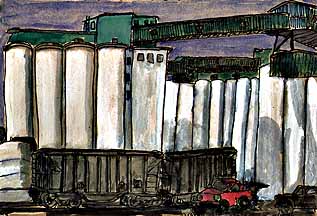
Quaker Oats (Bryce)
|
Watching the transformation of Grant Wood’s paintings from his
early days, you see how a sense of place can be reflected in a
style. Wood was no slouch as a French-influenced stylist. His
early work was very much in tune with the modern movement, but
after his commitment to Iowa (is that an artistic incarceration?),
his surfaces flattened, his patterning mimicked the quilted landscape,
even his portraits mirrored the openfaced planes of Iowa. The
dialogue between place and style informs the outsider. After viewing
a couple of rooms of Wood, the Iowa countryside pulls together
into a seamless mosaic. In fact, eastern Iowa is very beautiful,
once you acquire the vocabulary.
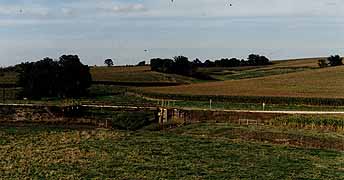
Iowascape
|
Back in the fall of ‘64 I drove to Iowa City with a native son
(John Bean) one dreary November day, and I remember my astonishment
while staring at a deadly monotonous landscape to hear him say
“Isn’t it beautiful?” I didn’t know whether to laugh or doubt
his sanity. Now I get it. He wasn’t crazy. |
Iowans aren’t crazy to live in Cedar Rapids, either. These small
Midwestern burgs are as hospitable as Bath, Maine, and about as
unhurried. Sparkling clean, courteous, industrious, and in this
case full of civic amenities and architectural charm, oats elevators
notwithstanding. Nobody seemed to mind when locomotives stopped
downtown traffic to shift oats wagons around. Maybe that was because
the railroad sidings were greenways with solid plantings of flowers
along brick walkways. Suited deskjockeys stopped and chatted amiably
while the Great Northwestern did its thing. Peggy lingered to
dig out the ancestral Foggs at the Hist. Soc. and the Pub. Lib.
while I hung out with the Quakers.
(Memo #15)
Sept. 19 - Grant Wood : Regional artist
Who? Grant Wood
What? American regionalist painter best known for "American Gothic"
Where? Iowa (Cedar Rapids Museum of Art)
When? 1920's and 1930's
How? trained in Europe, returned to home state to create art of
Iowa
Topics: American art, regional art. Grant Wood. American Gothic.
Paul Revere’s Ride. Daughters of the Revolution.
Questions: Can an artist capture and symbolize a region? Can an
artist be taken seriously as a regionalist painting his local
creek or pasture? Can you acquire naivete? Is the flat quality
of Grant Wood’s painting in the actual landscape, or is it a conscious
stylistic device? |
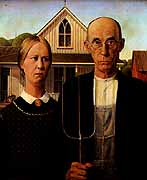
American Gothic
|
Iowa is Grant Wood land.. literally. Driving the side roads we
came to appreciate his technical expertise in rendering the complex
crazy quilt of plowed and planted fields, the hills and hollows,
the subtle variations of beige and gold and green. He also caught
the way the land at the edges of sight seems to curve, as though
you were looking through a fisheye lens. Traveling Iowa makes
me think Grant Wood was a skilled painter who captured a specific
landscape accurately, not the naive realist or the simple illustrator
his critics claim he was.
| The museums of Iowa feature Grant Wood and other regional painters.
He is the centerpiece of the Cedar Rapids Museum of Art, a fabulous
neo-deco building that mimics in brightly painted geometric shapes
a richly ornamented turn-of-the-century stone building attached
to it . The ornate capitals and columns of the older building
become bold pillars with top “brackets” in the new one. An atrium
and glass entries provide light and color. |
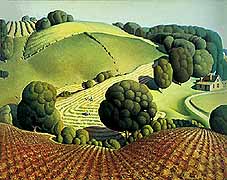
Spring Corn
(Grant Wood)
|
The museum’s large Wood collection destroyed several of my preconceptions.
Grant Wood did not simply paint flat landscapes and stark portraits;
he was adept as a fauve, impressionist, expressionist. He was
not a self-educated provincial primitive, but a well-traveled
artist who toured Europe, studying and miming the great painters
of Europe. A stark portrait of his mother holding a houseplant
was a conscious attempt to combine Renaissance portraiture (for
example, a distant background and formal pose) with elements of
the Midwest (a specific houseplant to symbolize the toughness
and hardiness of the region). We saw oils and pastels and lithographs
in a variety of styles from different periods in his life. We
saw soft French landscapes and bold animal studies and scenes
of Iowa farm life.
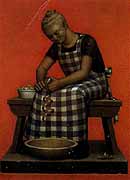
Hired Girl with Apples
(Grant Wood)
|
The exhibit text notes that “Grant Wood cultivated the persona
of a homegrown Iowa artist. (but) He was, underneath, a sophisticated
painter who traveled to Europe four times”, who chose to work
and live and teach in Iowa. He believed in art from, of, and for
his region.
The three American painters of the twentieth century usually associated
with Regionalism are Grant Wood, Thomas Hart Benton and John Steuart
(sic) Curry. All three worked in and painted the Midwest. Curry
believed “The artist must paint the thing that is most alive to
him.” Grant Wood believed, “everyday rural life had sincere and
lasting national meaning.” His paintings certainly convinced me. |
What's the role of the artist in his community? Grant Wood started
and led an Iowa art summer colony. He also donated many of his
paintings to schools, believing that children everywhere should
have access to art. Schoolchildren from “his” schools get into
the museum free. Grant Wood’s region is richer for regional art.
9/18..continued.
| We’d heard that a “landscape artist” had created a “crop art” installation at the airport, and was
going to have an aerial viewing and on-site fingerpointing that
afternoon, so we hooked up the implements and turned tractor towards
the aerodrome. |
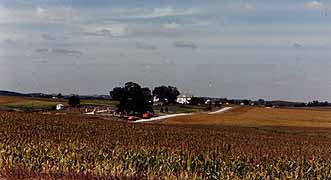
Installation?
|
Maybe it was a Cropside Happening. Cars driving round and round
dusty roads staring at cornfields.. looking for ART? Don’t know,
but that’s what we saw. The sheer giddiness of our staring at
all this al fresco Grant Woodiness, hoping to find THE BIG EVENT,
was too much.
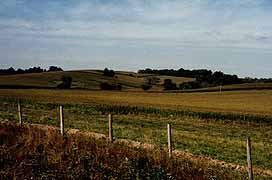
Another Wood
|
We grinned all the way to Amana. Or the Amanas. Once communal
villages settled by German immigrants, they are now a sort of
Freeport by the Communal Memory. A Shaker outlet-ville, or Amish
mall, if you will. I was having flashes of my mother taking me
into every gift shoppe on the Maine coast as a small child, so
I took a nap under a tree while Peggy did her snoop thing. |
Cheek to fender with the olde Amana quaint goods was the location
of the biggest farm implement fair in North America, only in the
first stages of setting up, unfortunately. But it was fascinating
to see crews heisting harvesters to the top of towers, and performing
other feats of showmanship with agricultural devices. But we had
to move on. The West was calling.
(Memo #16)
Sept. 19B - Intentional Communities : Amana
Who? Followers of the Church of the True Inspiration and leader
Christian Metz
What? seven communities once a self-sufficient communal society
Where? came from Germany, first settled in New York State, moved
to Iowa in 1855
When? settled in 1855, end of commune in 1932
How? successful business enterprises
|
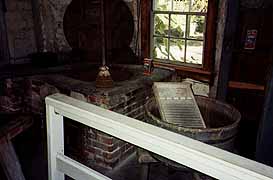
Communal Laundry at Amana
|
|
Topics: communes, American utopias / intentional communities,
group vs. individual, Maine-Shakers.
Questions: What are the advantages and disadvantages of communes?
Can a communal society survive in an individualistic society?
Have communes been successful economically? What should happen
when a commune or any community dies? How should it be preserved
or remembered? |
|
Picture Freeport, Maine, teeming with tourists. There are shops
selling a variety of goods, but all with reference to an extinct
communal society in Freeport. Descendants of the sect members
staff all the shops and museums, and the commune’s buildings are
all still there stuffed with knickknacks and retail goods produced
in Freeport. This is much what I found at Amana, Iowa. Or, rather,
the Amanas.
Southwest of Cedar Rapids, Iowa, are seven villages founded by
a group of German immigrants of the Church of the True Inspiration
or Amana colony. The sect formed in Germany and over 800 members
were lead to America by a charismatic preacher (Christian Metz)
to escape religious persecution. They settled first near Buffalo,
New York, and then moved to Iowa in 1855 for better, cheaper land
with varied resources. Also to escape temptation.
They created a communal society on 26,000 acres of bottomland
along the Iowa River where all goods were commonly owned, money
was unknown, tasks were performed for the good of the community,
often by an assigned group. Every family had a yearly credit allotment
at the village store. Every man owed one day of labor to the group
at harvest time. They remained German speaking with education
and church services in German. German customs and food and crafts
and architecture were maintained. The villages were agricultural
with all land and equipment held and used in common. The villages
typically had barns at one end, mills at the other, with brick
family houses along the streets.
The Amanas were ruled first by Christian Metz, then by the Brudderrat
(a Council of Elders elected by the people). This group made many
decisions that in the wider American society were made by the
individual: what your work would be, for example.
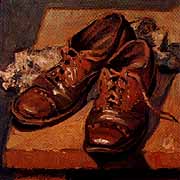
Old shoes
(Grant Wood)
|
The villages were largely self-sufficient. The men were farmers
and shoemakers and bakers and tailors and carpenters. Some Amana
men were selected to go out and get training as dentists and doctors
and pharmacists. Women worked in the communal kitchens preparing
food for the 40-50 people who ate together (though they lived
in family houses). Women did the gardening and housework (many
tasks, like laundry, were done in communal settings). Women’s
communal work was made possible by the childcare organized in
the villages for preschool children aged 1-5. After age 5 the
children went to the village schools (where German was compulsory
and the school was divided into study, play, and work periods).
|
The Amanas allowed for individual choice with supervision. Young
people could choose their own spouses, but the decision had to
be approved by the leaders. I saw no information on what happened
to those who could not or would not follow the Amana way. Did
they simply leave? Or was coercion used?
Unlike many utopian societies, the Amana proved to be pragmatic
at business, willing to interact with the wider society. When
the trains crossed Iowa, the Amanas built a station. The Amanas
also launched small enterprises to produce goods for the outside
world and bring in cash. Amana woolen good were woven in the villages,
cottons were intricately dyed and patterned, both for the world
market.
This society grew to seven villages and survived until 1932 when,
in an extraordinary action called the “Great Change”, the Amanas
voted to become non-communal, capitalistic, money oriented Americans,
partners in a profit-sharing corporation.
What really remains of Amana? Memories, curios, a few customs,
the buildings, museums. The 7 village churches are still there,
with two Sunday services, one in German and one in English. Descendants
still live in the houses and the items produced by the commune
are now made in privately owned firms.
The villages in another sense are an ethnic mall. Dozens of small
village shops hawk Amana goods, traditional bread and rootbeer,
furniture and ironmongery and woolens. Amana restaurants sell
Amana food, but there are also ice cream parlors and banks. Scores
of visitors in shorts and t-shirts walked the streets. The villages
host over a million tourists a year. They are the biggest tourist
attraction in Iowa.
Once again the Amanas have proved pragmatic, and the villages
have survived. This seems to be a lesson of our trip. We have
seen extremely depressed rural areas where farming is poor. Iowa
had vibrant farming communities. Other rural towns have found
gimmicks - Mark Twain in Hannibal; Superman in Metropolis,Illinois;
communalism in Amana; or outlets in Freeport. And they have survived.
|
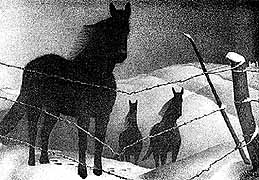
February
(Grant Wood)
|
America spawned scores of communes in the 1800s and continues
to create more (for example, The Farm, in Tennessee, which survives
from the 1960s). Partly this is due to the difficulty many Americans
have with unbridled individualism and materialism. Idealists search
for true brotherhood and equality. There is also the perennial
problem of balancing the needs of the group with the needs of
the individual. Among the best known American utopias are Brook
Farm, Oneida, New Harmony, the Shakers, Zoar, Cedar Vale. We hope
to visit the sites of extinct communes and living communes.









